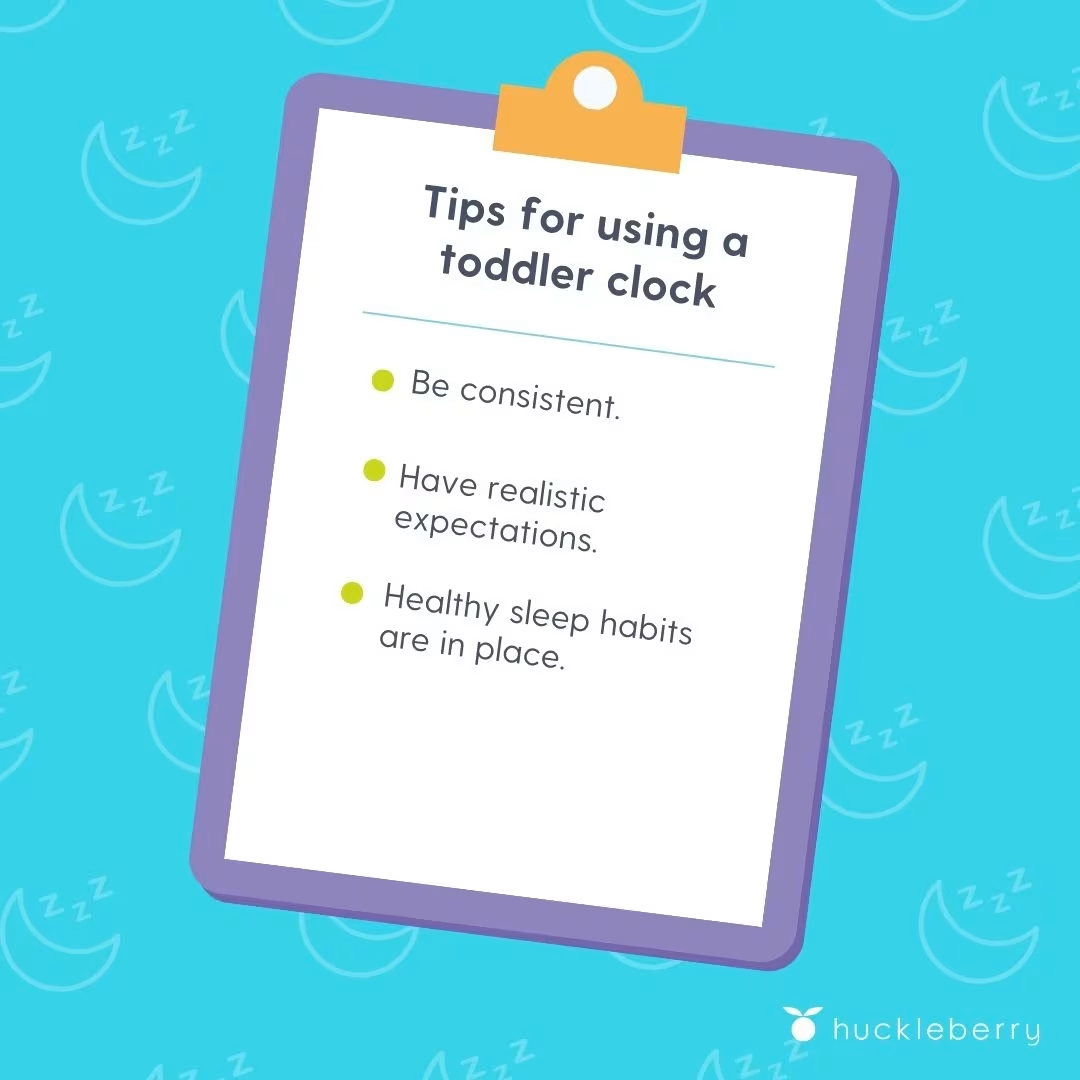A comprehensive guide on how to use toddler clocks
Updated Aug 14, 2025

Anyone with a toddler knows about the bedtime “asks” – one more book, one more sip of milk, one more trip to the potty, and one more (maybe the last?) ounce of your patience. It’s typical for little kids to push for more of everything at bedtime, and before you know it, bedtime is off the rails. Toddler clocks are a great tool for instilling healthy sleep habits and keeping bedtime struggles in check.
Table of Contents
What is a toddler clock?
Toddler clocks use colors, lights, sounds, and/or symbols, rather than numbers, to show pre-readers when it’s time to be in bed and when it’s an acceptable time to wake up.
At what age can I start using a toddler clock?
Most children who are 3 years old or older can comprehend a toddler clock coding system based on colors, symbols, or sounds. But you can begin teaching younger children how the clock works too. Some families have success with the toddler clock starting around 24 months of age.
Why toddler clocks matter
Children do best when they know what to expect and thrive when there are clear limits and . Toddler clocks give children a visual cue to follow, indicating when it’s time for sleep and when it’s time for play. If the bedtime routine begins every night when the clock turns red, they will begin to find comfort in this consistency. Repetition and consistency help little kids feel comfortable and secure.
Since toddlers understand the meaning of colors and symbols, toddler clocks give them an age-appropriate level of autonomy over bedtime. They’ll build independence each time they initiate the bedtime routine (when they see the red light or bedtime symbol). Your child can be in charge of noticing the color and dictating what happens as a result, eliminating the “it’s time for bed” power struggle, and fostering a more peaceful bedtime experience for all.
Parents can also use toddler clocks to assist in and correcting early waking. If your child wakes up in the middle of the night, claiming they are ready to start the day, blame the clock – if it's red, we stay in bed! The OK to wake up time is set by the clock, not the parent, which eliminates another power struggle.
Choosing the right toddler clock
Not surprisingly, there are a plethora of toddler clocks on the market, and they all work if used consistently and correctly (see below for detailed instructions on how to set one up). It really boils down to form or function, and which matters to you the most. Do you want a cute clock for your kid or do you want sophisticated programming options? And do you want to spend $20 or a heck of a lot more?
Toddler clocks range from quite simple, with just a light that changes colors to indicate when it's time for bed or when it's time to rise, to more complicated clocks with sounds, dimmable lights, actual digital clock components, alarms, and a variety of cute shapes and sizes. Some use lights only, some use pictures or symbols, some use both. They range in price from about $10.00 to $80.00+, but most fall somewhere around $30 to $40.
Here’s a rundown of 5 of the most popular toddler clocks parents use:
The Skip Hop Toddler Sleep Training Clock, Dream & Shine is a smiley-faced, cloud-shaped night light with three brightness levels and three sleep trainer settings: red = time for bed, yellow = almost time to get up, and green = OK to get up. It also has two soothing modes, white noise and rain sounds, and an alarm feature that plays a song in addition to the light. This one is cute and relatively simple.
The IT'S ABOUT TIME... Stoplight Sleep Enhancing Alarm Clock for Kids is an actual stoplight with a little figure attached (there are various options such as a little kid in a car, Elmo & friends, an owl, a train, or a dog). Most toddlers understand how stoplights work, and that red means stop and green means go. The yellow light serves as an optional nightlight. There’s also a digital clock and a beeping alarm clock feature. This one is fairly simple.
The LittleHippo Mella Ready to Rise Children's Trainer, Alarm Clock, Night Light and Sleep Sounds Machine uses both colors and facial expressions to indicate when it’s time for bed or OK to get up. There is also a yellow, almost time to start the day, color. It also offers three sound options and five-night light colors. There’s an alarm sound setting and a silent countdown setting for activities such as quiet time. This clock is visually appealing and has more features than some of the others on the market.
OK to Wake! Alarm Clock & Night-Light looks like a little bug with an antenna that has the standard toddler alarm clock color coding, as well as a nap timer and an alarm function. This is one of the original toddler clocks and remains popular due to its ease of use and multiple features.
Hatch Rest is probably the most commonly recommended toddler alarm clock device by sleep consultants, because of its multiple features and the fact that you can control it from an app on your phone. What makes it unique is the fact that you and your child can pick which colors designate which actions, the night light feature is dimmable, and there’s a wide variety of soothing sounds. Parents can adjust settings and set timers remotely with a smartphone, or control volume and nightlight by touch with buttons on the device. I like the adaptability of this device, but the features come with a higher price tag.
Setting up the toddler clock
The success of your kid’s toddler clock rests on how you set it up and how consistently you follow through. Follow these steps to ensure toddler clock success:
Step 1: Pick out the clock together. Or, if you already bought one, let your child open up the box. You’ll get more buy-in from them if it feels like a gift or a new gadget of their very own.
Step 2: Explain how the clock works in simple terms (e.g. “Red means bed,” “green means go,” or, “the stars mean it's time for rest and the sunshine means it's OK to get up and play.”
Consider drawing a picture together to solidify their understanding of the clock “rules.” For example, the picture could show two scenes: first, them laying in bed with their eyes closed, with a red circle next to the bed. Then, they are up and playing, the sun shining, and with a green circle.
Step 3: Practice during the day. After you’ve talked about how the toddler clock works, play pretend. When they notice the clock has turned on, practice the bedtime routine, and turn out the lights. They can pretend to be the parent and you the child, or they can put their stuffed animals or toys to sleep. Then switch! Keep it light-hearted and fun. Kids love it when parents fake snore.
Step 4: After the pretend play, discuss when you’ll start using the clock. Set the expectations and make them crystal clear. Will you start tonight? When the light is red, do you expect your kiddo to stay in their bed or are they just not allowed to leave their room? Do they have to stay quiet? Make sure they know exactly what’s expected. Tell them what happens if they disregard the clock. And stick to the rules – otherwise, you’ve only invested in an expensive nightlight.
Step 5: Set the clock time. Set the clock for their typical wake-up time (no matter how early that is!) to start. We want them to feel successful the first night they use the clock. When you waltz in and greet them with big smiles and high fives (even if on the inside you want to crawl back in bed for another hour or three), they’ll be proud of themselves. It feels good to succeed so they’ll want to do it again the next night – this is intrinsic motivation and so much growth can happen from here.
Move the clock’s OK-to-wake time later by 10 or 15 minutes every day or two, to gradually stretch their patience and give them more opportunity to fall back to sleep, and you’ll eventually reach a reasonable wake-up time that works for everyone. Please be reasonable! A toddler clock won’t keep your kid in bed until 8 AM if their internal biological clock is programmed to wake up at 6 AM.
Can a toddler clock help my child sleep through the night?
If your child is (i.e. goes into their sleep space while still awake and falls asleep without help from a parent through patting, rocking, or other means) at bedtime, then yes, a toddler clock can help them sleep through the night. Here’s how:
First, make sure that your child knows exactly what will happen if they call for you or leave their room at night. Will you silently return them to bed? Will you shut their door if they leave their room? Make the expectations clear. You can even practice during the day through role-play or with stuffed animals.
For example, if your child calls for you in the night, you might go to them, remain calm and bored, and point to the clock or say “The light is red (or whatever color or symbol is depicted), time for bed.” Nothing more. End of story. Then you go back to bed. Or, if they leave their bedroom, you might silently return them to bed and similarly point their attention to the clock. Or, respond in exactly the manner you discussed when you laid out the expectations during the day.
If you consistently follow your family’s “rules” regarding middle-of-the-night wake-ups and the toddler clock and remain consistent in your response, they will learn to sleep through the night.
For children who receive help from parents falling asleep at the beginning of the night, the toddler clock may be less effective.
Troubleshooting and tips for using a toddler clock
If you have a toddler clock and it’s not working, chances are you may want to regroup and consider implementing the tips below.

Tip #1: Be consistent.
If sometimes you follow the toddler clock rules and sometimes you don’t, your toddler will be confused and they won’t learn to stay in bed. You may have to weather a in the beginning, but if you hold the line and help your child stick to the toddler clock “rules,” they will learn. Patience and persistence are the keys to toddler clock success.
Tip #2: Have realistic expectations.
If you want your toddler to sleep until 8:00 AM and you’re hoping the toddler clock will be your golden ticket, you’re going to be disappointed. Determine what’s reasonable for your unique child – and honestly, that may be 6:00 AM – and let that be your goal. Set yourselves up for success.
Tip #3: Make sure essential healthy sleep habits are in place.
For example, if bedtime is mistimed, there is no bedtime routine to help anchor them into sleep mode. Likewise, if they nap too much or not enough, and/or they feel insecure in their sleep space, chances are that the toddler clock won’t change much.
Takeaway
Toddler clocks are a tool to help promote . Since toddler clocks use visual cues such as color coding and symbols, toddlers are able “read” the clock and exercise an age-appropriate level of independence and control at bedtime. When kids feel in control and know what to expect, they feel more secure and confident. When used consistently, toddler clocks also keep them in bed until it’s an OK time to wake.
What’s not to love about peaceful bedtimes and reasonable wake-up times? Toddler clocks are an effective tool to help you and your toddler establish routines that leave you well-rested.
Toddler clocks FAQ
Share article:
Note: The content on this site is for informational purposes only and should not replace medical advice from your doctor, pediatrician, or medical professional. If you have questions or concerns, you should contact a medical professional.
Table of Contents
Share article:









